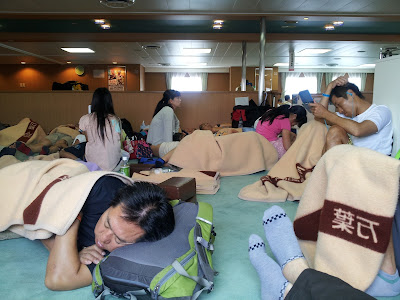Haven’t written about my second Ikitsuki trip and some other
doings in Nagasaki, but I’d like to blog about my excursion to Sotome while the
memory’s still fresh. One of the two Kirishitan 帳方 from
Sotome drove all the way down to Nagasaki to take me around Sotome yesterday.
First off, cannot be thankful enough for how nice the guy was – treated me to
lunch, tea, AND dinner, bought me “Doro somen”, a type of noodle that the
Catholic priest Marco de Rotz made for a living - on impulse when I asked about
it at the café, literally spent over 10 hours with me on his Saturday, the list
goes on and on.
Our drive through Sotome once again made me impressed with
how Japanese drivers maneuver through those impossible one-lane curves and
hills. Sotome is north of Nagasaki bordering the sea, surrounded by a pretty
scenic view with Goto in the very far distance. It’s also the site of the
Kakure Kirshitan in Endo Shusaku’s Silence,
one of my favorite novels to this day and the reason why I became interested in
Kirishitan in the first place. Apparently, Endo came up to Sotome himself to
ask the Kirishitan 帳方 at the time (the grandfather of the
current 帳方) if he could visit certain places to
contextualize the setting for Silence.
Ahh *impending geek alert*
Again, bummed that I don't have a proper camera and I'm just uploading all these mediocre ones from my phone. But Sotome is beautiful! View from Endo Shusaku Museum - almost can't tell the sky from the ocean.
Honestly, I felt like I was going on a Kirishitan “tour” as
I was driven every which way. First, we climbed up a hill to look at some
unknown Kirishitan graves, marked by a large, flat stones stacked on top of
each other as a gravestones, with teacups set on top by someone.
Graves of unknown Kirishitan
Afterwards, we
climbed up another hill to Karematsu Jinja, famous for being a shrine without a
torii gate because the Kirishitan used it as a shrine for a saint they called
San Juan-sama. Interestingly, there’s an ecumenical festival held every year
here by the local Buddhist priests, the Catholic authorities, and the Sotome
Kirishitan. We went inside the shrine for him to offer a prayer to San Juan-sama. He took showed me the stones placed in a bowl inside and said people kept them to protect themselves, giving me one to "write my thesis and graduate" (lol).
Karematsu Jinja
Then to the house of a former company president who collected items
as a hobby, some of which were Kirishitan artifacts. There was an iron pot with
a cross faintly inscribed inside and a crucifix in pretty good condition.
Finally, we made a detour to Ohno church, part of the pitch for Nagasaki's churches to be instated into the World Heritage List, and the former residence of another martyr, Bastian, who is
credited with passing on the calendar of Kirishitan observances that San
Juan-sama himself taught him.
The cross in the pot!
Finally, we stopped at his house where he showed me some
very, very old manuscripts of the Bastian calendar and orashio. Unlike the Goto
Kirishitan, the Sotome Kirishitan don’t have any Maria-sama figurines and the
like – probably destroyed in a fire, he said. My interview was definitely one
of the most interesting so far, if only because he had strong opinions and wasn’t
afraid to voice them. Echoing the Goto 帳方, he took pride in the fact that the Kirishitan religion didn’t
require money. He insisted that the Kirishitan religion, although it
incorporates elements from different religions, is something separate from
Buddhism and Catholicism. Moreoever, the Kirishitan religion that was preserved
for hundreds of years didn’t “change” from its original Catholic beginnings;
rather, it was the Catholic Church who had changed by the time the two groups
were able to interact with each other again in the Meiji era. Interesting idea
I definitely want to explore further.
A manuscript of The Beginning of Heaven and Earth, the sacred book of the Kirishitan
He drove me back to Nagasaki and took me up to Mount
Inaseyama to see the shrine of Kuwahime, the daughter of a Christian daimyo who
was exiled to the mountains. Her shrine is marked by two stones inscribed with
X’s that are said to be diagonal crosses.
The alleged crosses on Kuwahime's shrine
Finally, we went back to the station
where he treated me to some delicious チャンポン. Once again,
can’t get over how nice this guy was, and I wish I had something more to give
him than my customary Yale postcard.
Even though, I’m interviewing these people, I’m also
learning a lot from these older leaders, something that's sometimes hard to get
out of a four-year college experience where you’re limited to people your own
age. I think they also sense my age and just want to share their values with me
while I’m asking them questions.
Lesson of the day – You need to understand the history of
something as you research it. Going around to these landmark Kirishitan sites
isn’t direct fieldwork for the thesis I want to explore, but it’s been so helpful
contextualizing these people and how they value their Kirishitan ancestors and
background. Also need to transcribe all these interviews while I still have
time over here! (I know I’m just going to push off everything once I'm back at
school…)
The 帳方 in his garden
share on: facebook


























